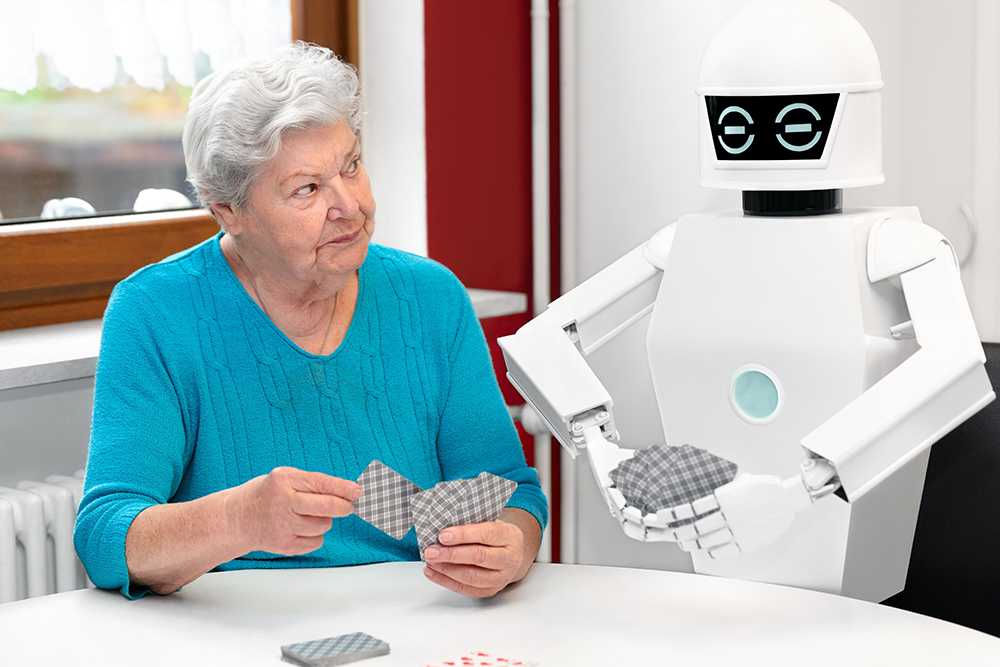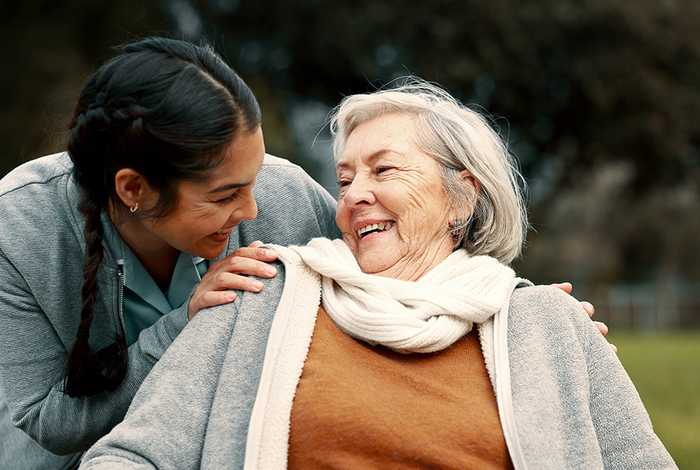Posted by Janine Griffiths
Guide to digital technology in care homes

Imagine a care home where fall-detection sensors alert caregivers in real time, video calling platforms keep residents connected with family at the touch of a button, and electronic care records ensure that every individual’s health needs are met with precision. These aren’t futuristic concepts—they’re happening right now in forward-thinking care homes across the UK.
Beyond compassionate staff and comfortable surroundings, modern care homes are now embracing digital technology to provide safer, more personalised, and more engaging care experiences.
The use of digital technology in care homes is not to replace human care; rather, it’s enhancing it, offering greater independence for residents, peace of mind for families, and efficiency for staff. From wearable health monitors tracking vital signs to AI-powered virtual companions providing emotional support, digital tools are making care homes safer, smarter, and more connected than ever before.
In this guide, we’ll explore how technology is revolutionising care homes, the benefits it brings to residents and their families, and what to consider when choosing a tech-enabled care home for your loved one.
Key areas where digital technology is transforming care homes
The adoption of digital technology in care homes is helping to transform many aspects of the care provided by care homes. Below we discuss some of the main areas where digital technology in care homes is revolutionising the support provided.
Health & wellbeing monitoring
In care homes, health and wellbeing monitoring has been greatly enhanced by digital innovations that allow staff to better track and respond to the needs of residents.
Wearable devices such as smartwatches and fitness trackers are equipped to monitor heart rate, blood pressure, sleep patterns, and physical activity.
These real-time health insights help caregivers quickly identify any changes in a resident’s condition and take immediate action, which can significantly reduce hospital visits and improve overall health outcomes.
Furthermore, remote health monitoring systems allow for continuous tracking without the need for constant in-person checks.
Residents can wear devices that transmit data directly to medical professionals, enabling quick responses to potential health issues.
Complementing this is the use of digital care planning and electronic health records (EHRs), which replace paper-based logs with secure, easily accessible digital records.
EHRs help create a personalised care plan for each resident, ensuring that all medical needs, medications, and treatments are properly documented and shared among healthcare providers for seamless care coordination.
Communication & social connection
Social isolation is a common concern for many seniors living in care homes, but digital communication tools are helping to bridge that gap.
Video calling apps, like Skype or Zoom, are now part of the care home routine, allowing families to connect with loved ones instantly, regardless of geographical distance. These regular virtual visits not only improve the mental wellbeing of residents but also help them stay actively engaged with their families and the outside world.
Additionally, some care homes are incorporating AI-powered companionship, such as robotic pets or virtual assistants, to provide emotional support for residents.
These smart devices can interact with residents, offering comforting voices and even encouraging them to partake in activities. Robotic pets, designed to look and feel like real animals, have been shown to reduce feelings of loneliness and anxiety, bringing joy and comfort to seniors in a non-threatening and low-maintenance form.
Safety & security
Safety is a top priority in any care home, and digital technology is playing a pivotal role in improving the security and wellbeing of residents. Fall detection sensors, integrated into clothing or placed in strategic areas, can immediately alert staff if a resident has fallen, enabling a swift response. These sensors are crucial in preventing prolonged distress and ensuring that help is on the way within moments.
Smart emergency response systems also help increase safety by automatically notifying staff and emergency services in case of an urgent situation, such as a heart attack or a stroke.
On a broader scale, digital access control systems help restrict access to specific areas of care homes, ensuring that only authorised personnel enter restricted zones. CCTV improvements can ensure greater oversight of common areas, adding an extra layer of protection for both residents and staff.
Staff support & workforce management
Efficient staff management is essential in maintaining high standards of care, and technology is stepping in to make this task easier.
Digital tools for rota management and shift planning allow managers to optimise staffing schedules in real-time, reducing gaps in coverage and minimising burnout among staff members. These tools also streamline administrative tasks, allowing caregivers to focus more on direct patient care.
To further enhance staff performance and skills, care homes are embracing e-learning platforms that provide ongoing education and training.
These platforms enable staff to stay up-to-date on the latest care techniques, healthcare regulations, and emergency procedures, all from the convenience of their mobile devices or computers.
Continuous education empowers caregivers to offer the best possible care while improving retention rates by investing in the professional growth of employees.
Smart environments & automation
Technology has also made its way into the physical environments of care homes, creating more comfortable and efficient spaces for both residents and staff.
Voice-activated controls are now commonplace, allowing residents to control lights, curtains, or even the temperature of their rooms with simple commands. These smart technologies enhance accessibility for residents with mobility or cognitive challenges, giving them a sense of control over their environment.
In addition, automated medication dispensers are helping reduce the risk of medication errors. These devices can be programmed to dispense the correct doses at specific times, alerting residents or staff if a medication is missed or taken incorrectly. This level of precision is crucial in preventing adverse drug reactions and ensuring that residents receive the appropriate treatments at the right time, enhancing both safety and compliance in the care home setting.
By integrating these digital technologies into every aspect of care home operations, facilities are not only improving the quality of life for residents but also transforming the way care is delivered. This ultimately makes care provision more efficient, connected, and responsive to the needs of today’s seniors.
The pros and cons of implementing digital technology in care homes
As digital technology in care homes continues to evolve, it brings with it a wide array of benefits that improve the quality of life for residents and streamline care operations. However, like any major shift, there are both advantages and challenges to consider. Let’s take a closer look at the pros and cons of integrating digital technology in care homes.
Pros:
The integration of digital technology in care homes is transforming the way care is delivered, making it more efficient, personalised, and connected. Here are some of the key benefits of embracing technology in care homes.
Enhanced resident care
One of the most significant advantages of digital technology in care homes is its ability to provide personalised care. With the help of wearable health devices and remote monitoring systems, caregivers can keep a close watch on vital signs, medications, and overall wellbeing. This real-time data helps ensure that any health concerns are detected early, preventing unnecessary hospital visits and improving overall outcomes.
Increased independence for residents
Technology also empowers residents to maintain more control over their lives. Voice-activated systems and automated features allow them to manage tasks such as adjusting room temperatures, turning on lights, or even making video calls to family members without needing assistance. These small but impactful changes promote independence and enhance dignity, giving residents a sense of autonomy.
Improved communication & social connection
With video calling apps and AI-powered companionship, residents can stay connected to their families and communities. For many seniors, social isolation can be a serious issue, but digital technology in care homes helps bridge this gap, allowing them to engage with loved ones in real time and even participate in virtual social activities.
Better staff efficiency
By automating administrative tasks such as shift planning and medication dispensing, staff members can focus more on providing direct care. Digital solutions streamline workflows, reduce human error, and even provide ongoing education to improve care standards, benefiting both residents and staff.
Cons:
While digital technology in care homes offers remarkable benefits, it’s not without its challenges. From costs to digital literacy, here are some key hurdles care homes may face when adopting technology:
Cost of implementation
Integrating advanced digital tools into care homes can be costly, especially for smaller or resource-constrained facilities. From purchasing devices and upgrading infrastructure to training staff, the initial investment can be substantial. While the long-term benefits might outweigh these costs, it remains a significant consideration for many care homes.
Technology overload
While the use of digital technology in care homes offers great promise, there’s a potential for over-reliance. Too much dependence on technology can lead to a disconnect between residents and caregivers, creating a sense of detachment. It’s essential to strike the right balance, ensuring technology complements rather than replaces human interaction and empathy in care.
Digital literacy challenges
For some older adults, especially those with cognitive impairments or limited familiarity with technology, the learning curve can be steep. Digital literacy may be a barrier, preventing some residents from fully benefiting from the tech in place. Similarly, staff training is required to ensure everyone is well-equipped to use new systems efficiently, which can take time and resources.
Data security and privacy concerns
The implementation of digital technology in care homes brings about significant data security risks.
With personal health data being stored and shared electronically, there is a growing concern about privacy and data breaches. Care homes must invest in robust cybersecurity measures to protect sensitive information, which can be costly and complex to manage.
The world of elder care is on the brink of a digital revolution. As technology advances at an unprecedented pace, care homes are beginning to embrace innovations that would have seemed like science fiction just a decade ago. From AI-driven predictive care to virtual reality therapy and smart home-style automation, the future of digital technology in care homes is not just about efficiency—it’s about creating richer, more personalised, and more fulfilling experiences for residents.
Future trends in care homes
The future of digital technology in care homes is set to redefine the way care is delivered. Emerging innovations are not just improving efficiency—they’re creating smarter, more connected, and more engaging environments for residents. Here’s a look at the exciting trends shaping the care homes of tomorrow.
AI & predictive analytics: smarter, more personalised care
Imagine a care home where health issues are detected before they even arise. Artificial intelligence (AI) and predictive analytics are making this a reality by analysing vast amounts of health data to spot early warning signs of conditions like infections, dehydration, or even cognitive decline.
AI-powered systems can assess patterns in residents' vital signs, sleep habits, and activity levels to alert caregivers to potential risks before they become serious issues.
This shift from reactive care to proactive care means fewer emergency hospital visits, better overall health outcomes, and peace of mind for both families and staff.
Virtual reality: therapy, travel, and time travel
For many residents, mobility limitations can mean missing out on new experiences. But with virtual reality (VR), they can travel to Paris, stroll along a beach, or even revisit their childhood home—all without leaving their chair.
VR is increasingly being used for reminiscence therapy, helping residents with dementia reconnect with their past through familiar sights and sounds. Studies show that VR can reduce anxiety, improve mood, and even stimulate memory recall, making it a powerful tool for emotional and cognitive wellbeing.
Beyond reminiscence therapy, VR is also being used for pain management, guided relaxation, and social engagement, providing residents with a window to the world beyond the care home walls.
The internet of things (iot): a fully connected care ecosystem
The future of digital technology in care homes is all about seamless connectivity. The Internet of Things (IoT)—a network of smart devices that communicate with each other—is set to revolutionise care homes by creating fully automated and responsive environments.
Picture this: a resident wakes up, and motion sensors automatically adjust the room temperature, turn on soft lighting, and notify caregivers if the resident is experiencing restlessness at night. Smart fridges can track nutritional intake, automated pill dispensers ensure medication adherence, and AI-powered assistants remind residents of daily activities—all working together in harmony.
With IoT, care homes become safer, smarter, and more intuitive, allowing caregivers to focus on meaningful human interactions rather than routine administrative tasks. As more care providers embrace digital technology in care homes, we move closer to a future where technology not only supports care but enhances the lives of residents in deeply personal ways.
The next chapter of elder care isn’t just about keeping up with technology—it’s about using it to empower, connect, and enrich. The care homes of the future won’t just be places of support; they’ll be places of possibility.
Looking for a care home?
Autumna can make it easier to find the perfect care home. Simply head over to our directory and type in your location to reveal a list of care homes in your area.
Our shortlisting tool can also help match you to an even more bespoke list of care homes that meet your specific requirements and circumstances.
You can also speak with one of our friendly and knowledgeable team members by calling 01892 335 330.
Receive a Free Care Home Shortlist!
Let our expert team of advisers get your search off to a great start.
Tell us a little about your needs and we'll send you a bespoke shortlist of care homes! Click the button below to begin, it takes just a few minutes.
Other articles to read
From the blog

Older Persons Care Advice
How to shortlist care homes in Exeter
April 17th, 2025
Looking for an adult day care centre near you? Discover how to find safe, joyful care for your loved one—and support for yourself—on Autumna.

Older Persons Care Advice
What is Discharge to Assess?
April 16th, 2025
Discover how Discharge to Assess (D2A) supports faster recovery, reduces hospital stays, and how Autumna helps simplify finding the right care.

Older Persons Care Advice
What are the benefits of person-centred care?
April 9th, 2025
Discover the benefits of person-centred care—from improved wellbeing to better outcomes—for individuals, families, and care providers alike.
Frequently Asked Questions
Digital tools enhance resident wellbeing by enabling real-time health monitoring, improving social connections through video calls, and increasing independence with smart home automation.
While not mandatory, many care homes are adopting digital solutions to improve care quality, streamline operations, and meet evolving regulatory and safety standards.
No, technology is meant to support—not replace—caregivers. Digital tools help automate tasks, monitor residents’ wellbeing, and improve efficiency, allowing staff to focus on personal care.
Care homes use encrypted electronic health records (EHRs), secure networks, and strict access controls to protect resident information and comply with data protection regulations.
The UK's largest & most detailed directory of elderly care and retirement living options
10,432
Care Homes
12,386
Home Care Services
1,670
Live-in Care Services
1,826
Retirement Living Developments
Autumna is the UK's largest and most comprehensive later-life living & elderly care directory. Our detailed search facility and team of expert advisors can help you find the best care homes, nursing homes, retirement homes, retirement villages, home care, and live-in care services for you or your loved one's needs. Our website is free to use, we are proudly independent, and we never take referral fees.






